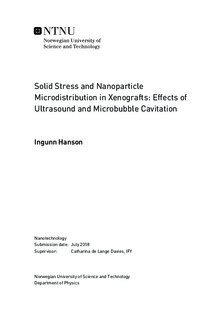Solid Stress and Nanoparticle Microdistribution in Xenografts: Effects of Ultrasound and Microbubble Cavitation
Master thesis
Permanent lenke
http://hdl.handle.net/11250/2563982Utgivelsesdato
2018Metadata
Vis full innførselSamlinger
- Institutt for fysikk [2686]
Sammendrag
A drug delivery system (DDS) was characterized for two different xenografts in mice: OHS and PC3. Nanoparticles (NP) encapsulating fluorescent model drugs were used as stabilizing shells around gas microbubbles (MB), and ultrasound (US) was used to locally cavitate and collapse the MBs at the tumor site. MB cavitation is known to induce several effects which are beneficial for NP drug delivery, causing increased accumulation, extravasation and extracellular matrix (ECM) penetration by the NPs. These effects all contribute to a higher tumor specificity and ability to reach all tumor cells, allowing for a safer and more efficient method of cancer treatment.Frozen tumor sections were imaged using confocal laser scanning microscopy (CLSM), and analyzed in terms of NP microdistribution. The distribution of solid stress (SS) in the tumors was characterized using the Planar cut method and subsequent US imaging. Tile scans from frozen tumor sections were fitted to surface plots (SP) of SS distribution in the same tumor, and a connection between SS levels and NP microdistribution was established.The baseline enhanced permeability and retention (EPR) effect of both tumor models was established, and found significantly higher for OHS tissue: the NP accumulation was 64.9% higher, the NP extravasation was 50.3% higher, and the ECM penetration was 35.2% higher in OHS tissue (p=0.01, p<0.0001 and p<0.0001, respectively, t-test). The DDS with US proved to be more effective for tissue with a lower baseline EPR effect.SS distribution was shown to be highly heterogeneous between tumors, and the level of SS was significantly higher in OHS than in PC3 tumors, by 99.5% (p<0.0001, t-test). For the first time, it was shown that treatment with US induced MB collapse lowered the SS in both tumor models: by 11.1 % in OHS tumors and 8.8 % in PC3 tumors (p=0.029 and p=0.030, respectively, t-test).The correlation between SS levels and NP microdistribution was heterogeneous. PC3 tumors showed no effect of the US treatment on the correlation between SS level and NP accumulation, extravasation or ECM penetration, which were all negative for both groups. OHS tumors, on the other hand, experienced a change from positive to negative correlation between SS level and NP accumulation, and a change from no correlation to a positive correlation between SS level and NP extravasation after treatment.
